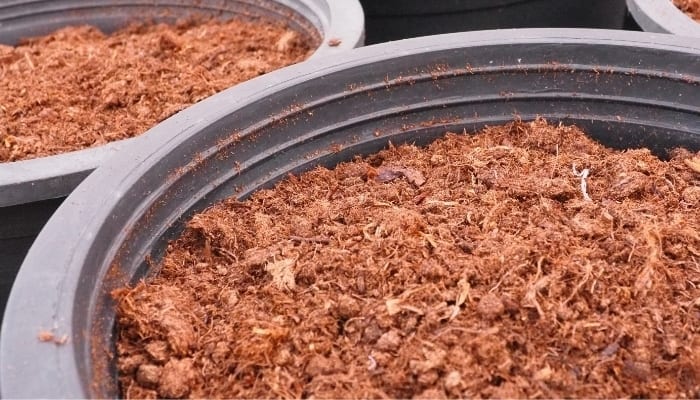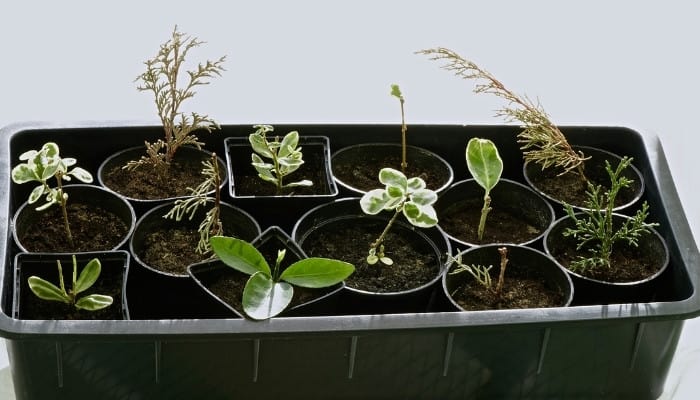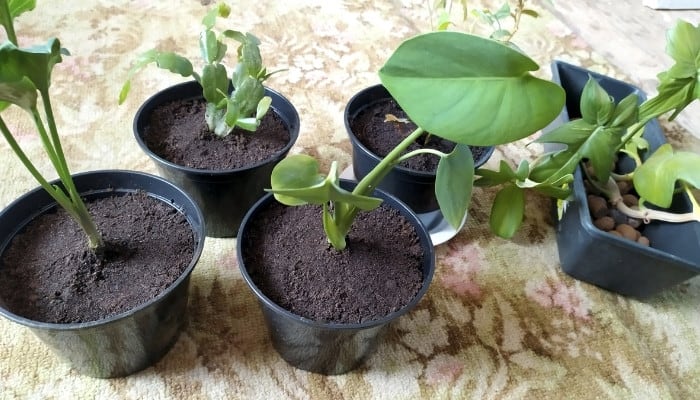If you wish for your new plants to thrive and prosper, it is important to understand the most effective mediums for propagating root cuttings.
What is the best medium for rooting cuttings? Potting soil, peat moss, perlite, vermiculite, sphagnum moss, LECA, and coco coir are among the very best mediums for root cuttings. However, the best medium for your specific root cuttings depends on several factors including the plant species, local environment, time of the year, and more.
Continue reading below to discover which mediums are best for root cuttings, when to use them, and what makes each one so effective!
Mediums for Rooting Cuttings
Taking a root cutting from a plant is easy; simply dig the plant up and remove around 1/4 to 1/3 of the parent plant’s root system.
The next step is planting your root cuttings in the best medium possible.
But first, apply rooting hormone, like the one I use, to the tips of the roots and any sections that you cut or accidentally snapped off.
To do so, just dip the roots straight into the rooting hormone powder or liquid. From there, plant them straight away.
Early spring through early fall, while the plant is still in a full-on growing cycle, is the best time to take root cuttings.
Taking root cuttings during dormant stages yields poor to no results at all.
The average root cuttings take three to four weeks to grow large enough root systems to be potted or planted.
Soil

One of the most commonly used mediums for growing anything, including root cuttings, is soil. It is best used wet for root cuttings.
Soil can also be mixed with peat moss, perlite, and other mediums like LECA for a firmer but equally moist environment for root cuttings.
A major drawback to soil is that it isn’t as “clean” as other methods – not only in that it makes more of a mess but also in that it is more prone to bacteria and disease.
Properties & Benefits
Soil offers a moist and nutritious environment for root cuttings. It also provides a dark environment for roots that prefer less light.
Furthermore, the soil is a great base or additive for root cutting mediums.
Plants To Use With This Medium
Nearly anything that can be propagated with root cuttings will grow in soil. Granted, the best soil for the job varies depending on plant species and other factors.
Water

A simple but effective medium for root cuttings is plain old water. Just take your cuttings and stick them in mason jars or glasses full of clean, fresh water.
The cleaner and fresher the water is the better. You should change the water your root cuttings are soaking in at least two to three times per week.
Dip the tips in rooting hormone before plopping them into water.
Properties & Benefits
Water is easy to clean and sterilize and simple to change out every few days. It also allows for better visibility.
Also, you can monitor root cuttings that are soaking in water just by looking through the glass once per day, which is far easier than with any other medium.
Plants To Use With This Medium
As with soil, most plants that you can grow from root cuttings will start to develop new roots simply by soaking in freshwater.
That said, woody-stemmed plants and tree cuttings (find out what works and what doesn’t in this article) may not respond as well in just water.
LECA

This medium is also sometimes called clay balls, due to their mainly round appearance.
When LECA becomes wet, it absorbs the moisture and slowly releases it directly to the roots of the plants.
LECA can hold water for weeks at a time, depending on how much you water it.
For roots, you can “shower” the LECA with fresh water every 24 to 48 hours and let the excess water drain out of the bottom of the container.
Properties & Benefits
LECA holds moisture better than other mediums and is much easier to remove and transplant things into than soil and other mediums that actually grow plants (unlike water).
This medium is also less prone to disease, bacteria, and pests than soil, water, and most other mediums.
You can learn all about LECA balls in my article here.
Plants To Use With This Medium
Just about any plant that you can think of that grows from root cuttings does well with LECA.
Simply stick the root into a container with pre-soaked LECA, pour some extra water on it, let drain, and set it to the side to let nature take its course.
I’ve seen good results using these LECA balls.
Perlite

Somkak Sarykunthot | Dreamstime
When it comes to getting root cuttings to “take” and start new root systems of their own, perlite is one of the very best mediums to use.
Perlite is easy to work with and yields excellent results.
Simply fill a container up with perlite, stick the root cutting in, and finish filling the container up, firming it up around the cutting as you go.
If the cutting falls over, try repotting it with a bit of sphagnum moss (this small bale is a good bargain) in the mix.
Properties & Benefits
With soil, peat moss, or even sand, perlite is a crucial moisture retainer, and the cutting or plant gets more nutrients from the additional medium.
You can expect to see signs of new growth on your root cuttings in as little as two to three weeks when using this medium.
Plants To Use With This Medium
Perlite is best used with root cutting and plants that prefer to stay moist constantly or for extended periods of time. I highly recommend this brand of perlite for the best results.
Vermiculite

Mona Makela | Dreamstime
Vermiculite, or magnesium-aluminum-iron silicate, is a mineral that has the ability to absorb 300% to 400% of its weight in water.
In addition, it attracts beneficial nutrients such as calcium, magnesium, and potassium.
One reason that people tend to lean towards perlite over vermiculite is that it doesn’t provide as much aeration as perlite does.
Properties & Benefits
Vermiculite is a naturally occurring mineral in nature that’s made up of lots of cool stuff that plants need, like iron and magnesium.
Its main benefit to root cuttings is how much water it can absorb and feed back to roots over time.
Plants To Use With This Medium
Vermiculite is great to mix with perlite and potting soil, or even sand. If kept moist enough, root cuttings may sprout new roots within 10 to 15 days.
If you choose to use vermiculite either on its own or added to other mediums, I’d go with an organic mix like this one, especially if you’re rooting plants that will one day produce food.
Coco Coir

Sikth | Dreamstime
Coconut coir is a great substitute for other mediums. For root cuttings, coco coir has very successful growth rates but does require a bit more water than others.
Coco coir needs watering at least once per day when used for root cuttings or seedlings. When you place it outside or put it under lights, it requires double watering.
If it dries out completely, it may dry out your precious roots along with itself. One option is to use a coco coir mix that contains perlite for additional water retention.
Properties & Benefits
Coco coir is one of the easiest mediums to keep moist, due to its high moisture retention rate. It also holds nutrients very well, offering more sustenance to roots over the long run.
Coco coir also has less shrinkage as well as superior aeration and draining abilities to boot.
Plants To Use With This Medium
Coco coir is best to use with roots that require being extremely wet.
Besides straight water or dirt soup, coco coir is easily the best medium for plants that need extra moisture for their roots. It is also a great substitute for peat moss in soil mixes.
Sphagnum or Peat Moss

Burapa Nammulsint | Dreamstime
Sphagnum and peat moss are also excellent mediums for root cuttings and are actually among the very best.
Both types of moss have extremely high water retention rates and help hold nutrients longer than soil, sand, and perlite.
Sphagnum moss in particular is great for tree roots and other woody-stemmed root cuttings due to its long and fibrous nature.
Properties & Benefits
Among their most beneficial properties are their abilities to reverse compact soil, aerate the soil, and retain moisture and nutrients longer than other mediums.
Plants To Use With This Medium
Sphagnum and peat moss are more than ideal for most root cuttings, seedlings, and plants in general.
They are best mixed with other mediums such as soil, sand, and potting mixes.
Sand

Sand does indeed work well for many root cuttings.
It may not be as nutritious as other mediums, but it does offer a firm hold on cuttings, keeping them well-anchored and allowing for quick draining and space for roots to grow and thrive.
Sand is best as a medium when it’s mixed with a bit of rich soil or potting mix. That way it has the ability to retain more water and nutrients for the plant roots.
Properties & Benefits
The main benefit of sand as a rooting medium is that it offers excellent drainage and good anchoring for cuttings.
Another benefit is that it doesn’t compact in the same manner as the soil does and therefore allows plenty of room for new root systems to develop and spread out.
Plants To Use With This Medium
For root cuttings that need to be constantly moistened but not exposed to excessive amounts of water, sand is perfect.
You can water it multiple times per day and all excess water will drain out quickly.
Soilless Mixes

These mixes are typically made up of three, four, or even five or six ingredients.
The most common mediums found in soilless mixes are sand, pebbles, river rock, peat moss, sphagnum moss, perlite, vermiculite, and tree bark (usually from pine trees).
A few of the best soilless mixes for root cuttings include:
- Peat moss, perlite, vermiculite, and tree bark (30 to 40% peat moss and equal parts of each other ingredient)
- Half perlite, half sphagnum moss
- Peat moss, sand, vermiculite, and coco coir (40% peat moss, and equal parts of each other ingredient)
Properties & Benefits
The main benefit of soilless mixes, in general, is excellent drainage yet high water and nutrient retention rates.
These mixes typically need far less watering than other mediums. In addition, soilless mixes are far less prone to harmful bacteria, disease, and pests commonly found in soil.
Plants To Use With This Medium
The beauty of mixing your own soilless medium is that you can make a perfect growing medium for whatever specific root or plant type you’re dealing with.
Caring for Your Cuttings

After taking cuttings and setting them up in the best medium there are several aftercare factors to consider and keep up with.
Keep in mind also that it is best to research each root type in addition to applying general care for cuttings.
Watering
Root cuttings require watering every day. Depending on the medium, they may need as much as two to three waterings per day.
After the first two weeks, watering sessions should be reduced.
For cuttings soaking in jars of water, make sure to replace the jars with fresh clean water every three or four days.
Lighting
Most root cuttings don’t require light for the first couple of weeks after they’re cut. Root cuttings thrive and begin developing new roots in darkness.
However, after some time passes, and roots begin to appear, introducing them to sunlight or growing lights is necessary for them to transform into healthy new plants.
Humidity Level
The humidity level that root cuttings are stored in after being cut and potted is crucial.
Most gardeners suggest a humidity level of 80 to 85%. Some gardeners even recommend a 100% humidity level.
The bottom line is that your root cuttings need to be stored somewhere where they won’t dry out and neither will the medium they’re potted/stored in.
Temperature
Most root cuttings survive at temperatures between 50°F and 70°F. That said, the most ideal temperature for root cuttings to quickly develop is 73°F to 77°F.
Keep in mind that the bottom of the containers that hold the root cuttings is the most important area to keep warm (the root zone).
Protecting From Pests
Pests are not a usual issue with fresh root cuttings, but there are always exceptions.
Likewise, even if you selected a pest-free cutting, there is always a chance that pests may find their way to the cuttings or its growing medium.
To prevent pest damage, use sterilized mediums, tools, and containers when dealing with your root cuttings.
Also, try organic pesticides like sprinkling the top side of the medium with cinnamon or spraying it with lemon juice, water, and white vinegar.
Preventing Bacteria and Disease
A few of the most common practices for preventing bacteria and disease from infecting root cuttings include:
- Sanitizing tools, containers, and mediums.
- Selecting clean and healthy cuttings.
- Regularly checking the cuttings for signs of bacteria or disease.
- Keeping the medium free of weeds and insects.
- Storing the root cuttings in a dark and cool place.
When To Fertilize Plant Cuttings
Fertilizing new plant cuttings is actually not a very good practice. In order for root cuttings to begin developing new root systems, they need a “reason.”
Having been cut from their parent plant and removed from their natural environment, they have that reason.
However, if you start feeding them nutrients, they may become lazy and simply soak up the nutrients provided rather than shooting out new roots in an attempt to search for nutrients.
Transplanting Rooted Cuttings

After root cuttings develop an inch or two of new roots, they are ready for transplanting.
The basic steps for transplanting roots are:
- Remove the cutting from its current medium.
- Carefully rinse the soil or medium from the roots.
- Allow the roots to soak in freshwater for several minutes.
- Prepare the ground or container for planting.
- Remove the cutting from the water, and place it in the ground or container.
- Cover the roots with at least 2-3 inches of soil or growing medium.
- Apply water.
Depending on the sort of plant you’re dealing with, the amount of light it needs or the best place to sit it after transplanting varies.
Related Question:
Why Do Cuttings Fail?
Cuttings may fail for several reasons, the most common being that they were not healthy plants before being cut, the wrong part of the plants were cut, the cutting was executed poorly, the cutting dried out, too many nutrients were provided, or the wrong medium was used.
So, Which Medium Is Best for Your Root Cuttings?
Depending on what you’re trying to grow from root cuttings, you should have no problem if you pick a healthy plant to take the cutting from, treat it with care, and use a proper medium.
You’ll also need to keep your cuttings moist, humid, and in the dark, for at least a couple of weeks before you see any real growth.
Picking the best medium helps ensure your root cuttings have enough water, warmth, air, and space to develop roots.

